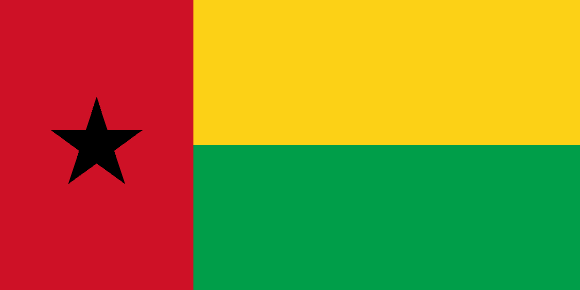Guinea-Bissau Flag

Guinea-flag Bissau's is composed of three horizontal stripes of equal width: yellow at the top, red on the left side, and green on the bottom. A black five-pointed star is also featured in the center of the red band on the flag. The flag's design is primarily influenced by Ghana's flag, which was the first to utilize the Pan-African colors of red, yellow, green, and black in 1957.
According to Ghanaians, the black star represents African unity, the crimson star represents the blood spilt during the independence struggle, the yellow star represents the sun, and the green star represents hope.
Guinea-Bissau chose its flag in 1973, when the country proclaimed independence from Portugal. The flag's colors and design were inspired by the banner of the African Party for the Independence of Guinea and Cape Verde (PAIGC), a political party that played a key role in the independence fight and is still the dominant party in Guinea-Bissau today. The colors of the Guinea-Bissau flag have the same connotations as those of the Ghana flag: crimson represents martyrs' blood, green denotes forests, and gold represents the country's natural wealth.
Guinea-Bissau flag downloads
- completely free for commercial and non-commercial use (public domain)
- based on vector file from Wikipedia Commons
- PNG or WebP format (lossless compression)
- Right click on the links (save link as)
| Width | Height | PNG | WebP |
|---|---|---|---|
| 20px | 10px | ~0.1 KB | ~0.1 KB |
| 40px | 20px | ~0.4 KB | ~0.1 KB |
| 80px | 40px | ~0.7 KB | ~0.1 KB |
| 160px | 80px | ~2.6 KB | ~0.6 KB |
| Width | Height | PNG | WebP |
|---|---|---|---|
| 16px | 12px | ~0.1 KB | ~0.1 KB |
| 40px | 30px | ~0.4 KB | ~0.1 KB |
| 80px | 60px | ~0.8 KB | ~0.1 KB |
| 128px | 96px | ~2.5 KB | ~0.6 KB |
- completely free for commercial and non-commercial use (public domain)
- based on vector file from Wikipedia Commons
- PNG, WebP (lossless compression) or JPEG format (100% quality)
- Right click on the links (save link as)
| Width | Height | PNG | WebP | JPEG |
|---|---|---|---|---|
| 2560px | 1280px | ~2.6 KB | ~0.6 KB | ~34.9 KB |
| 1280px | 640px | ~0.7 KB | ~0.1 KB | ~13.0 KB |
| 640px | 320px | ~0.4 KB | ~0.1 KB | ~5.6 KB |
| 320px | 160px | ~0.2 KB | ~0.1 KB | ~2.8 KB |
| 160px | 80px | ~0.1 KB | ~0.1 KB | ~1.5 KB |
| 80px | 40px | ~0.1 KB | ~0.1 KB | ~0.9 KB |
| 40px | 20px | ~0.1 KB | ~0.1 KB | ~0.6 KB |
| 20px | 10px | ~0.1 KB | ~0.1 KB | ~0.4 KB |
- completely free for commercial and non-commercial use (public domain)
- based on vector file from Wikipedia Commons
- SVG, PDF (Adobe Acrobat), AI (Adobe Ilustrator) or EPS format
- Right click on the links (save link as)
| Format | SVG | AI | EPS | |
|---|---|---|---|---|
| Vector download | ~0.3 KB | ~12.5 KB | ~29.7 KB | ~1533.8 KB |
Country information
Guinea-Bissau is a country located in West Africa. It is bordered by Senegal to the north and Guinea to the east and south. The capital of Guinea-Bissau is Bissau, which is located on the coast and is the largest city in the country.
Guinea-Bissau has a population of approximately 2 million people, and the official language is Portuguese. The country has a diverse population, with more than 20 different ethnic groups. The main religions in Guinea-Bissau are Islam and Christianity.
Guinea-Bissau has a tropical climate, with high temperatures and high humidity throughout the year. The country is home to a number of national parks and protected areas, which are home to a wide range of plant and animal species, including gorillas, chimpanzees, and elephants.
The economy of Guinea-Bissau is primarily based on agriculture, with the main crops being rice, cassava, and millet. The country is also an important producer of peanuts, and the fishing industry is a significant contributor to the economy. The manufacturing sector is also an important contributor to the economy, with the country producing a wide range of products, including textiles, clothing, and electronic goods.
| Independent | Yes |
| Country codes | GW, GNB (ISO 3166-1) |
| Official name | Republic of Guinea-Bissau |
| Official languages | Portuguese |
| Religion | 46.1% Islam, 30.6% Traditional faiths, 18.9% Christianity, 4.4% Others / None |
| Capital city | Bissau |
| Continent | Africa |
| Time zone | UTC (GMT) |
| Member of | United Nations |
| African Union | |
| Organisation of Islamic Cooperation | |
| Population | 2,086,202 (2023) |
| Population density | 70 per Km2 (181 people per mi2) |
| Urban Population | 44.9 % of the population is urban (884,232 people in 2020) |
| Migrants (net) | -1,399 |
| Median age | 18.8 years |
| Total area | The total land area is 28,120 Km2 (10,857 sq. miles) |
| Highest point | / |
| Lowest point | / |
| GDP per capita | $ 795 (World Bank, 2021) |
| Currency | West African CFA franc (Fr, XOF) |
| Calling code | +245 |
| Internet TLD | .gw (click here to find and register domain name) |
| Country Wikipedia Page | Guinea-Bissau Wikipedia Page |
Main Cities by Population in Guinea-Bissau
| # | CITY NAME | POPULATION |
|---|---|---|
| 1 | Bissau | 388,028 |
| 2 | Bafata | 22,521 |
